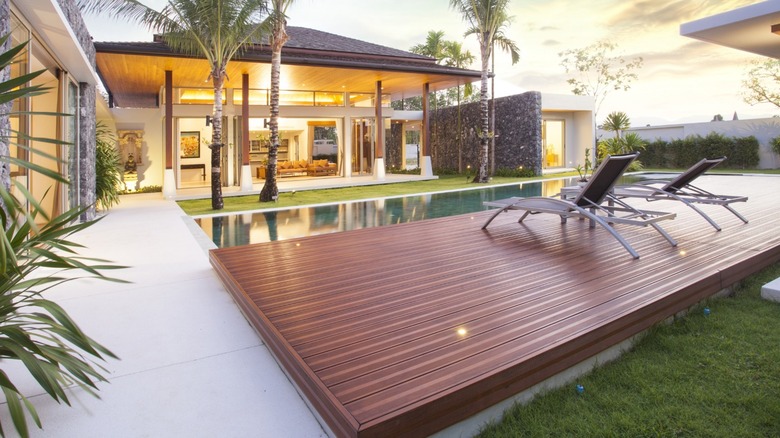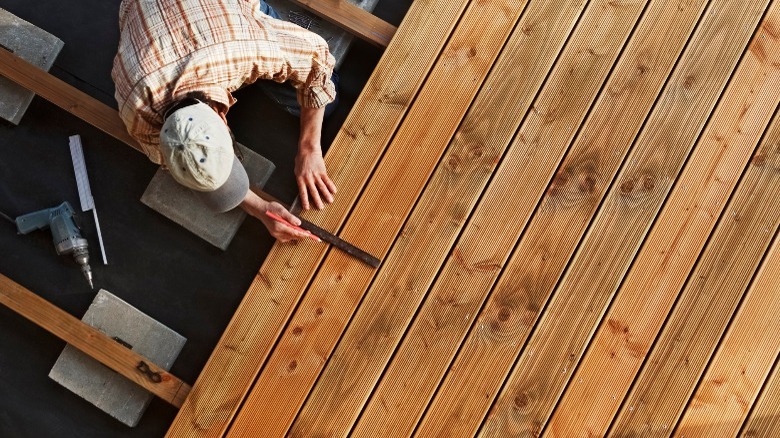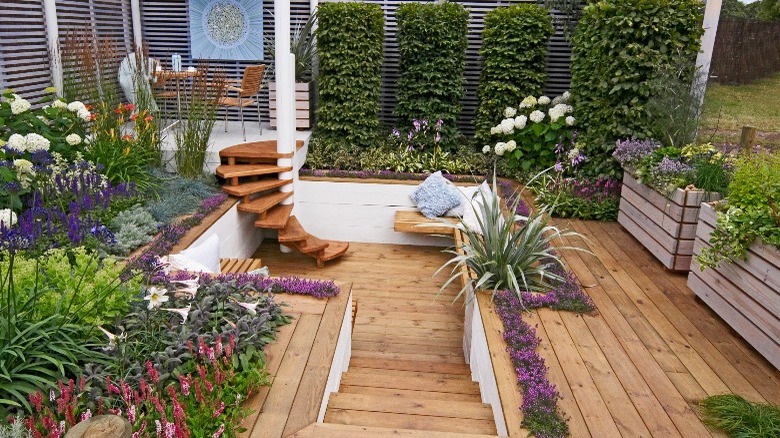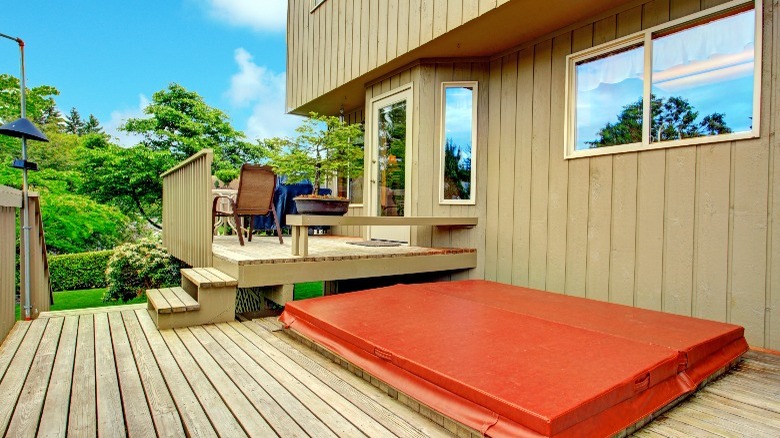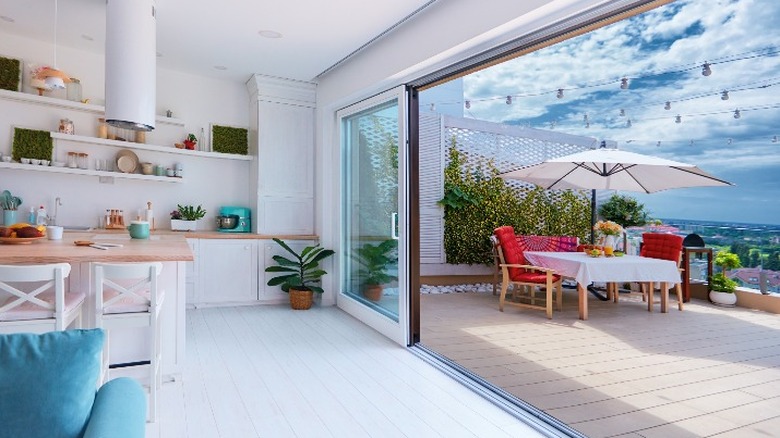How Much Does It Cost To Build A Deck?
A well-designed deck is a great way to increase your usable living space and make the most of your outdoor area. According to Iron River Construction, beyond aesthetics, decks are ideal for alfresco dining, exercising, reading, and entertaining. They also make a good location for a hot tub and cut down on the amount of regular yard work and maintenance needed.
When it comes to the design of a deck, you are only limited by your own imagination. The Spruce notes that while some are relatively compact and serve only as a raised entryway to a home, others can be much larger and may have multiple levels, or be used to link two parts of a property together.
The most common material for a deck is hardwood, according to Consumer Reports. Hardwood is both tough to wear and tear and weather-resistant, as long as it is treated with the correct products. In general, a hardwood deck will cost around $15 to $35 per square foot, with an average total of $2,200 for a 100 square foot deck (as per HomeGuide). Alternatively, more modern deck materials such as composite, plastic, and aluminum are also popular for their durability, however, these options do tend to increase the overall project cost.
Factors for cost
There are several key considerations that will affect the overall price of a new deck. Choosing the most suitable material will depend primarily on the look you hope to achieve, however, it is also important to consider your location and climate. In addition, Woodland Deck Company notes that you need to weigh the benefits of installing the deck yourself against the cost of a professional installation.
Deck material
As mentioned, hardwood is the material most commonly associated with a deck. Fantastic Gardeners points out that hardwood is durable and can have a lifespan of up to 50 years if properly maintained. It is also available in a variety of colors and stains, which can either help the deck blend in with its surroundings or contrast with your home decor to create a stand-out feature. Hardwood decking planks range in price depending on the type of wood. Redwood and cedar, for example, cost around $4 to $8 per square foot, whereas mahogany or walnut run about $15 or $20.
If you live in an area with extreme weather, then even the best quality hardwoods can deteriorate over time due to rainfall or sunlight exposure. The Spruce explains that in those cases, it may be better to choose plastic, aluminum, or a polymer composite, as these are virtually maintenance-free, weather and stain-resistant, and in some cases fireproof, too.
Foundation and framing
Equally as important as the deck material is the structure it's built on. Bob Vila advises that decks require significant support structures, especially if they are expected to accommodate many people or additional weight from outdoor furniture or a hot tub. Generally, the deck will require poured concrete footings and pressure-treated wooden framing, notes HomeAdvisor, which costs around $10 to $20 per square foot. However, raised decks will need additional support beams and deeper footings, which can increase the overall cost to $30 to $50 per square foot.
Labor costs
If you have adequate DIY skills and the necessary tools, installing a basic deck is not overly difficult. However, HomeServe notes that complex designs, raised decks, and decks with multiple levels can be challenging and certain elements may need to be professionally inspected. They also pointed out that hiring a contractor accounts for roughly two-thirds of the total cost. Therefore, it is recommended you request quotes from multiple companies, as installation costs can vary significantly. On average, you can expect to pay anywhere from $8 to $22 per square foot for labor, depending on the size of the deck, the type of material, and the elevation it's built on.
Additional costs
Along with the primary material and labor costs, there are several aspects that also need to be budgeted into the total price of the deck. For example, you may decide to have the deck professionally designed if it requires a complex layout or additional support structures. In addition, any extra features such as stairs, railings, and electrical work will need accounting for.
Planning and design
Depending on where you live and the size of your proposed deck, you may need to apply for planning permission or a building permit. HomeGuide advises checking with your local authorities or homeowner's association before commencing work. They also point out that since a deck will increase the value of your home, it may raise your property taxes. To be sure, you should have a local property appraiser assess the deck once it is completed.
Finishing and maintenance
Although hardwoods are naturally resistant to shrinking and warping, decks.com points out that the timber will need sealing to protect it against extreme heat, rot, fungal growth, and insect damage. It is recommended to seal all sides of the hardwood planks before installing them to ensure the underside is adequately protected, too. In addition, Bob Vila states that decks made from natural products will need to be sanded and resealed at least once a year, and that typical labor costs for yearly maintenance can range from $500 to $1200.
Features and final touches
Beyond the expense of the deck itself, the type of finishing touches you decide to include will have a significant impact on the overall cost. According to Decks & Docks Lumber Co., if a deck is 30 inches or more from the ground, most residential building codes require a railing be added. At this height, you will also likely need steps to access the deck. Costimates noted that wooden deck stairs can add $115 to $210 per stair if professionally installed. Any additional features such as lighting and power sockets, built-in furniture, privacy screens, or a heater will also need to be planned and budgeted for in advance.
Types of deck
The size, type, and design of the deck are often determined by its location in relation to your house, according to The Spruce. A popular choice is in a yard at the front, side, or the back of the property. However, for homes with complex layouts or built on a slope, there are many creative options to consider.
Wraparound decking
If you are fortunate enough to have enough space to accommodate it, a wraparound deck can be installed on two or three sides of your home and at different elevations. This can have several advantages, notes Connect2Local. Not only are wraparound decks spacious enough to fit plenty of people, but they also allow you to easily move in and out of the sunlight throughout the day. In addition, you will be able to enjoy the different views from around your home, and hopefully catch a sunrise or sunset.
Multi-level decking
Multi-level decks are ideal for properties that are built on a slope or in an area that changes in elevation. They provide a sense of spaciousness and may consist of several smaller decks linked together with steps or paths. The Deck Store explains that a multi-level deck creates more functional space from less square footage. They also have the advantage of being able to incorporate unusable areas — such as hills and rocky landscapes — into the design. Just keep in mind that building on multiple elevations will undoubtedly increase your overall labor and material costs.
Unique decking
If your available space is scarce, there are plenty of creative ways you can incorporate a deck. Houzz has many useful suggestions, such as building a deck above a garage or rooftop, or incorporating natural features like trees and boulders into the structure. Another option is to locate the deck away from your property, at the end of the garden perhaps, which could also provide additional privacy.
Why you need a new deck
According to Better Homes & Gardens, people's outdoor expectations are just as important as the interior of their home. A deck is a great way to bridge the divide between your indoor and outdoor life. In many cases, a well-designed deck can become part of your daily living space.
Property value
As mentioned, a deck will often increase the value of your home and make it more desirable to potential buyers. In fact, Homes.com points out that because an added deck increases a home's overall square footage, homeowners can often expect to recoup up to 100 percent of the cost if they decide to sell their house. In addition, wooden decks rank fifth in the top features that appeal to home buyers, via Better Homes & Gardens.
Safety issues
If your home already benefits from a deck, there are several reasons why you may consider replacing it. Lifetime Exteriors explained that although hardwood decks can have a considerable lifespan, those that are over 20 years old will often show visible signs of deterioration. They recommend having a professional inspection conducted for issues like split or rotting planks, unsecured framing, loose railings, missing or rusted hardware, and signs of insect or termite infestation. If a deck has serious structural problems or multiple minor issues, it is often more cost-effective to replace it entirely, rather than investing time and energy into costly repairs.
Benefits of building a deck
Three out of four homeowners commented that they have a greater sense of enjoyment and an increased desire to be at home after completing a deck, as per Homes.com. There is little doubt that the increased space for an outdoor lifestyle is one of the major reasons why people find decks so appealing. If you are still unsure, however, here are a few more factors that might sway you.
Aesthetic appeal
Iron River Construction points out that one of the best things about a deck is that it is completely customizable, which allows you to fully dictate the layout, color, material, and added accessories. You can aim to make the deck blend in with your surroundings by incorporating natural elements, or create a design feature that makes your property stand out. You can be sure that however you decide to build your deck, it will be a pleasure to look at and to spend time on.
Functionality
Decks are not only about aesthetics though. According to BuildDirect, decks increase your living space and add functionality to a home. They can be used for entertaining and dining, and provide a safe place for your children to play outdoors, while still under supervision. In addition, raised decks can add storage space to a property. MasterPLAN Outdoor Living notes that the area under your deck is an ideal place to store lawnmowers, gardening equipment, outdoor furniture, or pool accessories, so long as it's built to be accessible.
Less maintenance
Last but not least, a deck can actually reduce the amount of yard work and outdoor maintenance necessary. GardeningEtc says that decks drastically reduce the amount of work your garden will need. This ultimately means you will spend less time pulling weeds, mowing lawns, or raking leaves, and more time relaxing outdoors instead. Caring for the deck itself usually requires little more than an occasional sweep with a stiff-bristled brush.
